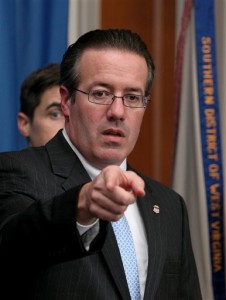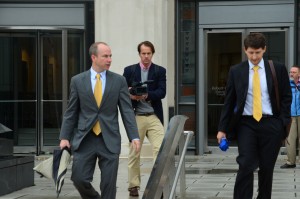Prosecutors seek to block video, Blanchard re-cross
November 2, 2015 by Ken Ward Jr.
With no trial proceedings today, attorneys in the Don Blankenship criminal case are still busy. Yesterday evening, government prosecutors filed two new legal briefs: One aimed at continuing to keep the jury from seeing a video of Massey Energy safety meeting, and another that argues against allowing defense lawyers another shot at questioning former Performance Coal Co. President Chris Blanchard.
On the issue of the video, U.S. District Judge Irene Berger previously blocked the defense from using footage of a 2009 meeting at Scott High School where Massey kicked off what defense attorneys are touting as a major new safety initiative. Defense lawyers have edited the video, trying to remove portions that Judge Berger said were not admissible as evidence in the case. Still, Assistant U.S. Attorney Gabriel Wohl says the edited version also shouldn’t be allowed:
The fragmented clips of five different Massey executives (Chris Adkins, Mike Snelling, Keith Hainer, Jason Whitehead, and Elizabeth Chamberlin) are objectionable for the same reasons the earlier video was held inadmissible. The out-of-court statements are general puffery and opinion being offered for their truth. They are part of a scripted, videotaped, exculpatory presentation orchestrated by a company conscious of the value of generating helpful evidence in the event of future litigation. The danger of the statements being considered for an improper purpose outweighs what little probative value, if any, they hold.

On the issue of the defense’s request to re-cross Blanchard — which came up at the end of re-direct on Friday afternoon — U.S. Attorney Booth Goodwin filed this 16-page brief, apparently in response to a specific request from Judge Berger for more legal arguments on the matter:
The parties received an email from the Court’s chambers early on the morning of October 31, 2015 to the following effect: “Part of the basis of the Defendant’s motion to re-cross Mr. Blanchard is that impeachment questions were based on grand jury testimony which was taken out of context. The Judge asks that the Defense designate the questions and the relevant portions of the transcript, and forward the same to me by e-mail and to counsel for the United States no later than 8:00 Monday morning.”
It’s interesting to note that the email from Judge Berger’s chambers asks that the legal arguments over the defense’s re-cross request be hashed out in emails between the parties and the court, while Goodwin’s office chose to file its brief as part of the court docket — where the public can see it.
Among other things, the government brief notes:
After the luncheon recess on Thursday, October 22, 2015, the United States called Blanchard to the stand. The United States completed direct examination of Blanchard mid-afternoon Friday, October 23, 2015, at which time, Defendant began cross examination. Defendant resumed cross examination on Monday, October 26, 2015 and continued cross examination until almost mid-day Thursday, October 29, 2015—a total of almost 4 days with an intervening weekend to continue to prepare for the bulk of such cross examination.
The United States began Blanchard’s re-direct examination shortly before lunch on Thursday, October 29, 2015 and concluded near the end of the day on Friday, October 30, 2015.
Defendant has had more than ample opportunity to confront Blanchard. Defendant’s cross examination well exceeded the total amount of time the United States examined the witness. As would be readily apparent from a review of the cross examination, Blanchard—someone designated as one of Defendant’s co-conspirators—was largely co-opted as a witness for Defendant. Defendant introduced more than 165 exhibits through Blanchard on cross examination.
Interestingly, Goodwin publicly filed with this brief a copy of Blanchard’s grand jury testimony. As we’ve noted before, a transcript of this testimony was briefly filed publicly before by the defense, only to quickly be removed from the court’s electronic docket system. UPDATED: The newly filed copy of Blanchard’s grand jury testimony has now been listed as “restricted” on the court website and is not available to the public. We still have it posted online here, though.
Regarding whether the defense should get to re-cross Blanchard on the specific questions raised about his grand jury testimony, the new government brief says:
All of the questions posed by the United States concerning Blanchard’s grand jury testimony were directly related to the inconsistent answers provided to similar questions on cross examination. Blanchard’s responses to questions posed in the grand jury were confirmed by him during re-direct examination with no further need to explain them. There is no contextual ambiguity to the questions asked in grand jury or to the answers provided to those questions.
The government brief concludes:
Defendant’s stated bases for re-cross are unavailing; they all relate to areas of the redirect that did nothing more than test evidence introduced on cross-examination. Defendant has had more than ample opportunity to confront Blanchard. The scope, length and substance of the cross examination went well beyond that which are required by the Confrontation Clause of the Sixth Amendment to the Constitution. With his request for re-cross, Defendant simply wants further opportunity to present elements of his case through the easier vehicle of cross examination of Blanchard. Defendant has already indicated that it intends to put on a defense in this case, and he is certainly able to call Blanchard in his case. Given such an opportunity, and the fact that no new matters were raised on re-direct examination, there is no risk of running afoul of the Confrontation Clause. Defendant’s oral motion for re-cross examination should be denied.

 Subscribe to the Coal Tattoo
Subscribe to the Coal Tattoo
